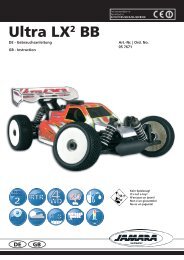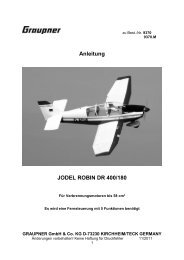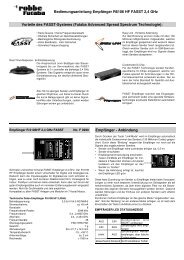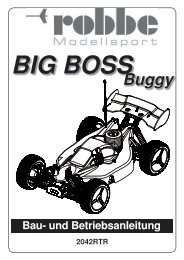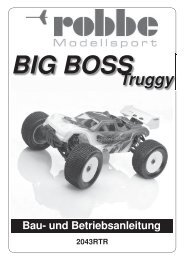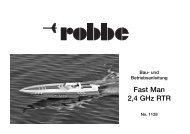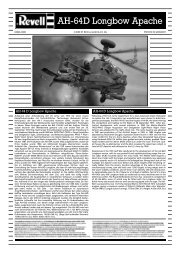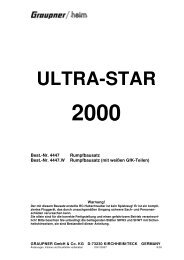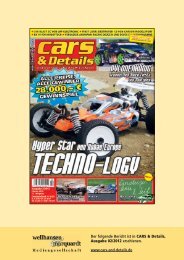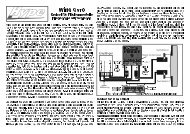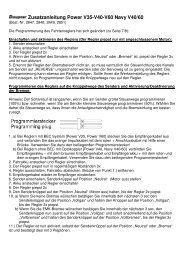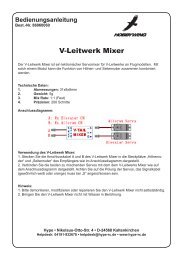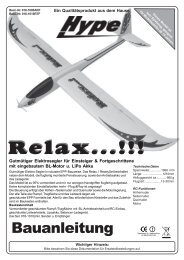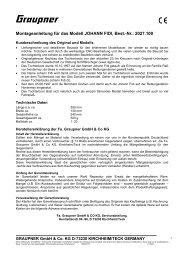You also want an ePaper? Increase the reach of your titles
YUMPU automatically turns print PDFs into web optimized ePapers that Google loves.
Specification<br />
Overall length: approx. 820 mm<br />
Overall beam: approx. 300 mm<br />
Draught: approx. 140 mm<br />
Displacement: approx. 10,000 g<br />
Scale: 1 : 20<br />
Essential accessories not included in the kit are listed on<br />
the separate sheet, as are suitable adhesives.<br />
See the main robbe catalogue for details of tools and aids<br />
to building.<br />
Fittings Set, No. 1026, and Power Set, No. 1027<br />
These two sets are required in order to produce a boat of<br />
scale appearance which is capable of running on the water.<br />
Particular parts from the Fittings Set and the Power Set are<br />
required early on in the construction of the boat, and for this<br />
reason it makes good sense to obtain them before you start<br />
building the model.<br />
Sequence of assembly<br />
The <strong>Le</strong> <strong>Courageux</strong> is designed for the advanced model builder.<br />
We therefore assume that you have a certain minimum level<br />
of experience in modelling procedures, and in these instructions<br />
we do not go into details of preparatory work such as<br />
breaking out die-cut parts, drilling holes, cutting strip material<br />
and wire to length, painting individual parts, etc.<br />
Some stages are only sketched in, and are intended simply<br />
to indicate possible methods and to stimulate your own<br />
ideas.<br />
In basic terms the numbering of the components reflects<br />
the sequence of assembly.<br />
Please read through the instructions, referring to the parts<br />
lists, the illustrations and the plan, so that you have a clear<br />
idea of how each section goes together.<br />
The photographs show the parts and sub-assemblies in<br />
<strong>Le</strong> <strong>Courageux</strong><br />
their unpainted state, as this generally makes it easier to<br />
understand the arrangements. Some detail photos show the<br />
finished, painted components on the completed model.<br />
Vacuum-moulded parts<br />
Assembly and operating instructions<br />
Sand the cut edges of the vacuum-moulded parts smooth<br />
after cutting away the scrap material.<br />
Drill holes in the vacuum-moulded components at the marked<br />
points, using the sizes of drill stated in the illustrations.<br />
Machine-cut and die-cut parts<br />
Don’t separate these parts from their support sheets until<br />
you need them for the stage in hand.<br />
The identification drawings are intended to help you locate<br />
individual parts. Write the part number on each component.<br />
When gluing parts together, ensure that punched points are<br />
left exposed, and are still accessible for drilling.<br />
Don’t throw away the scrap material (sheet, strip and wire),<br />
as it may be needed later to make other small parts.<br />
All surfaces which are to be joined must be sanded beforehand<br />
to ensure that the glue adheres well.<br />
Use only the stated and recommended adhesives.<br />
Read and observe the instructions supplied with the various<br />
adhesives.<br />
Before gluing any parts together check “dry” (no glue) that<br />
they are an accurate fit.<br />
Note that Stabilit-Express should never be applied in the<br />
form of thick fillets; spread the adhesive out thinly.<br />
All glued joints involving holes in the hull, i.e. where water<br />
could penetrate (e.g. the rudder bush, propeller tube, etc.)<br />
should be sealed all-round with a thin fillet of Stabilit-<br />
Express.<br />
Parts should be held together using clamps or adhesive<br />
tape while glued joints are drying.<br />
2<br />
No.<br />
1025<br />
Small quantities of cyano-acrylate (Speed Extra, Speed<br />
Type 2) should be applied on the tip of a pin or a length of<br />
thin wire.<br />
When soldering railing components and similar parts<br />
together, use a hot iron and complete each joint quickly, as<br />
excess heat could easily damage the plastic (superstructure,<br />
platforms etc.). Alternatively you may wish to make up a<br />
simple jig for shaping and soldering the individual railing<br />
sections before they are installed on the model.<br />
Clean up all soldered joints carefully. All the metal parts<br />
should be prepared thoroughly prior to painting by rubbing<br />
them down with fine abrasive paper and removing all traces<br />
of grease.<br />
Fit a separate heat-shrink sleeve over each soldered joint<br />
between electrical cables.<br />
Directions such as “left” and “right” are as seen from the<br />
stern of the model, looking forward.<br />
All dimensions in the text and the illustrations are stated<br />
in mm.<br />
Notes on painting<br />
Wooden parts should be given two or three coats of wood<br />
wax to render them waterproof.<br />
Any gaps between plastic parts can be made good using a<br />
plastic filler paste such as robbe rostuff-micro. Sand the filler<br />
back flush when it has set hard.<br />
Parts to be painted must be cleaned thoroughly beforehand<br />
by wiping them with methylated spirit or similar (not cellulose<br />
thinners). Try not to touch the surfaces at all between<br />
cleaning and painting. Before applying the colour finish to<br />
the hull we recommend that you give it a coat of primer and<br />
rub it down to obtain a smooth surface.<br />
If you wish to obtain a clean, neatly delineated colour scheme,<br />
you must paint the model’s components in a particular<br />
sequence:<br />
Each part which is to be a different colour should first be<br />
trimmed to fit accurately on the boat, then painted, and



